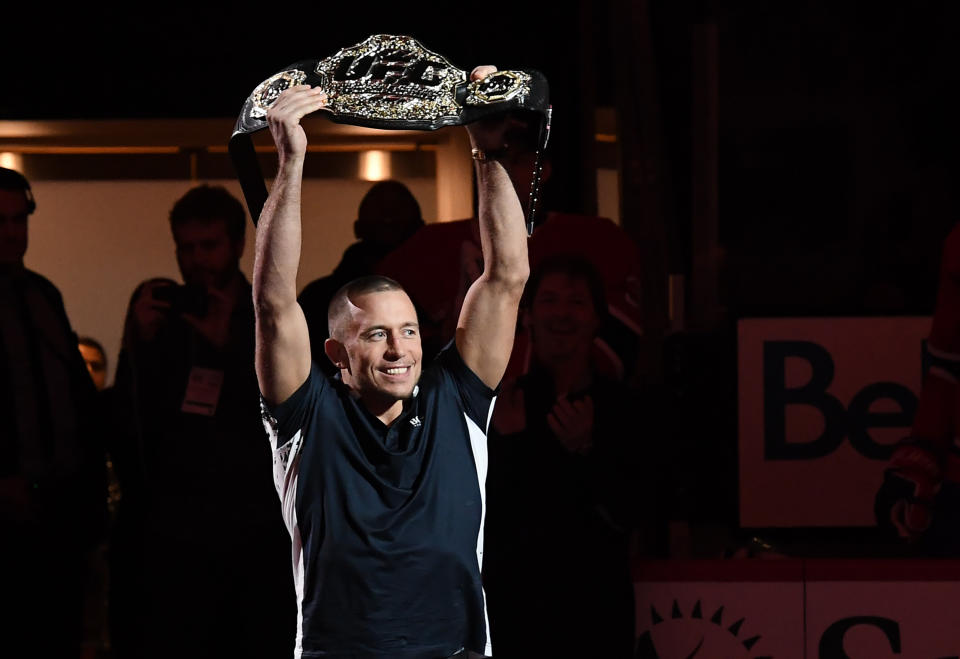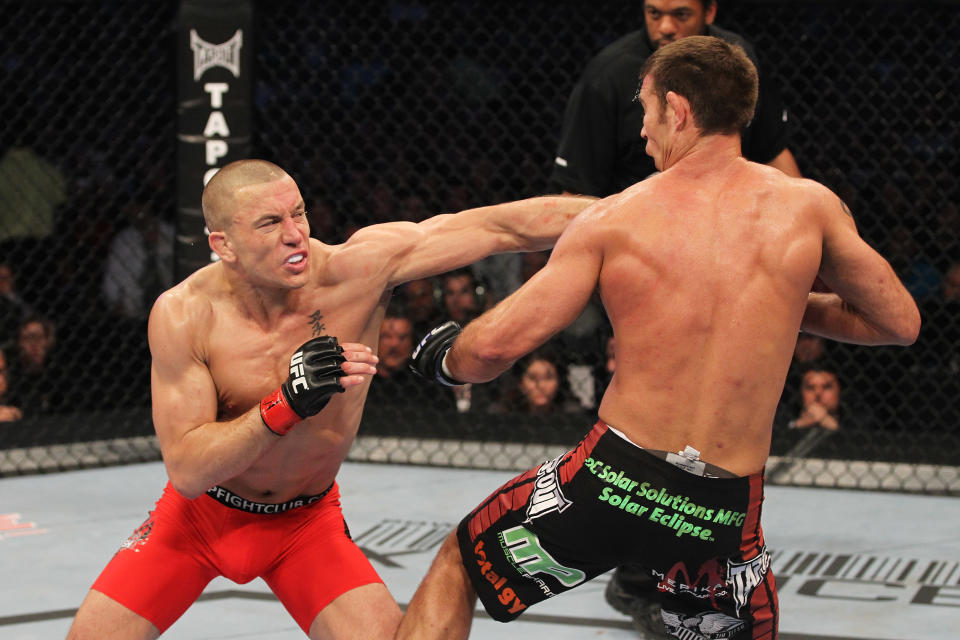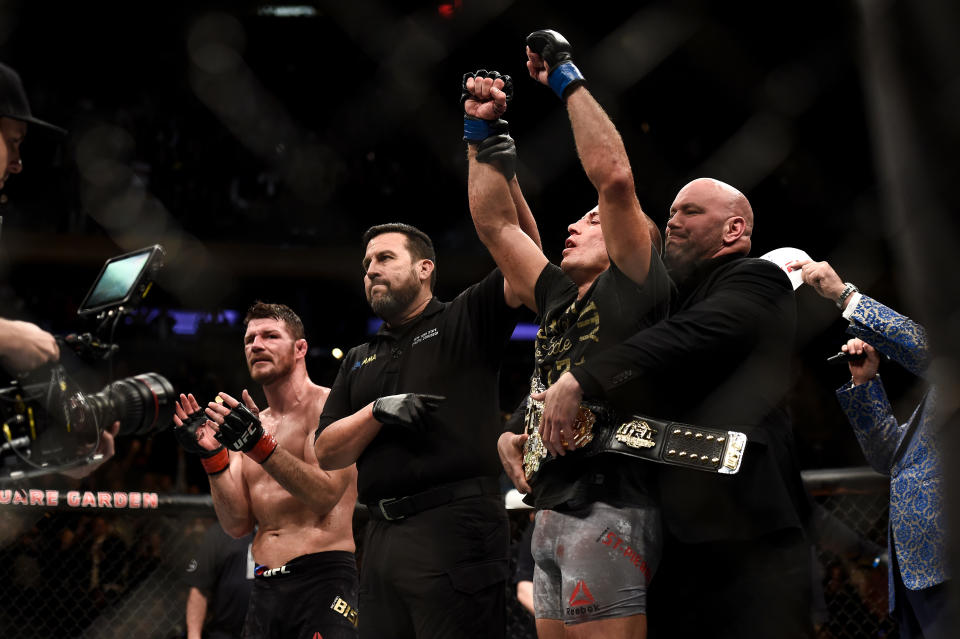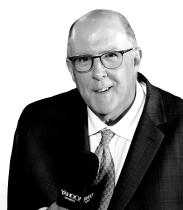Georges St-Pierre was and always will be the epitome of a mixed martial artist
Right around the time that Georges St-Pierre met Matt Hughes for the welterweight title at UFC 50 in Atlantic City on Oct. 22, 2004, news broke that the promotion was more than $40 million in debt and primary owner Lorenzo Fertitta tasked company president Dana White with finding a buyer.
The story is well known by now: Six months later, the finale of the first season of the reality series “The Ultimate Fighter” was a massive success, and UFC and Spike officials hammered out terms of the UFC’s first TV deal in the parking lot of the arena on the UNLV campus. The company soared in value to such a point that it sold for more than $4 billion in 2016.

None of that happens without St-Pierre.
St-Pierre, who according to a report from Ben Beaudoin of RDS is expected to announce his retirement at a Montreal news conference on Thursday, gave the UFC its first mainstream international star.
He crossed barriers that no one before him had crossed, and few have since.
St-Pierre’s emergence came less than a decade after the late Sen. John McCain’s brutally incorrect assessment of mixed martial arts as “human cockfighting.”
If anyone ever proved McCain’s words were egregiously wrong, it was St-Pierre. He was a polite and charming and respectful man who happened to be an elite athlete. He never stopped working to better himself and could always be counted upon to be prepared for his fights both physically and mentally.
He had an impact upon MMA similar to what Oscar De La Hoya had on boxing a decade or so earlier. After winning a gold medal in the 1992 Olympics in Barcelona, De La Hoya became one of his sport’s biggest attractions. He was handsome, outgoing and attracted a much higher than average female audience.
The same was true of St-Pierre, who helped give the sport a legitimate base of female fans. Like De La Hoya, he was bilingual and that opened an entirely new audience of fans. St-Pierre had the added benefit of turning Canada into one of the UFC’s best markets.
Canadian fans packed arenas throughout the country to cheer on GSP, and it wasn’t long after UFC 83, the promotion’s first event in Canada, that White was calling it “The Mecca” of MMA. Of course, it was St-Pierre who attracted a UFC record crowd of 55,724 to the Rogers Centre in Toronto to watch him defeat Jake Shields at UFC 129. That show remains one of the most significant in UFC history.

St-Pierre’s prominence in Canada undoubtedly helped convince other young athletes in his country to consider MMA, and it wasn’t long before Canada was consistently producing high-end fighters as well as filling arenas.
He showed them the way it was done, seeking out the best opposition, diversifying his game, training maniacally and doing it without ever using performance-enhancing drugs. He retired in 2013 after a controversial win in Las Vegas over Johny Hendricks at UFC 167, and much of it was motivated by his anger at what he perceived as an out-of-control and largely unchecked PED problem.
At that time, White would defend the UFC’s lack of a formal drug-testing policy despite the large number of positive tests by saying, “We’re tested by the government.” Testing by state athletic commissions clearly wasn’t sufficient, though, and St-Pierre’s outspokenness on the matter played a large role in the UFC doing the right thing and implementing a rigid anti-doping program in 2015.
He was a bridge from the sport’s early days, when Royce Gracie and Ken Shamrock, and then Chuck Liddell, Tito Ortiz and Randy Couture were the big attractions to the current era in which fighters like Conor McGregor and Ronda Rousey became mainstream superstars and the sport got deals on network television and ESPN.
He didn’t do the overwhelmingly large pay-per-view numbers that McGregor did, but after he established himself as a star, every one of his pay-per-view shows was an event and were always among the most successful of the year, sales-wise.
He showed his greatness as a fighter when he returned at UFC 217 in New York after nearly four years away from the game and defeated Michael Bisping to win the middleweight title. He’d talked a lot in his career about going up in weight, but St-Pierre was adamant that if he did, he’d do it the right way.
He built his body slowly over the period of a year and added the bulk that was necessary to compete with the much bigger opponents he’d see at middleweight.
He finished Bisping with a rear-naked choke to become at the time just the fourth UFC fighter to hold a belt in two divisions.

The sport has moved on and the UFC continues to draw big crowds and sell a lot of pay-per-views. It’s a testament to the work that St-Pierre did in preaching the gospel of MMA and converting people who tuned in because they’d heard about him from a friend and turned into long-term fans of the sport.
He’s one of the greatest fighters who ever lived and there were few hints of controversy surrounding him. He was an example to so many in so many ways.
He’s the epitome of what a mixed martial artist should be: brave, fearless and confident but also classy, respectful and sportsmanlike.
He took up karate as a young boy to learn how to defend himself against bullies and used that base to become one of the biggest stars of his time. He was voted the Rogers Sportsnet Canadian Athlete of the Year in 2008, 2009 and 2010, notably at a time when Sidney Crosby, one of the greatest hockey players ever, made two trips to the Stanley Cup Finals, won once and scored the winning goal in overtime to lead Team Canada to a gold medal at the 2010 Olympics in Vancouver.
Hockey is religion in Canada, and the fact that St-Pierre topped Crosby in the Athlete of the Year voting at a time when Crosby was at his peak speaks volumes about the respect and the greatness of St-Pierre.
Count yourself fortunate if you were able to witness him in person. There haven’t been, and probably never will be again, many like him.
More from Yahoo Sports:
• State of emergency: Lakers ‘concerned about LeBron’
• ESPN exposes extent of NBA ref’s betting scandal
• Brown: Padres’ simple reason for signing Machado
• Sign up for 2019 Yahoo Fantasy Baseball today

